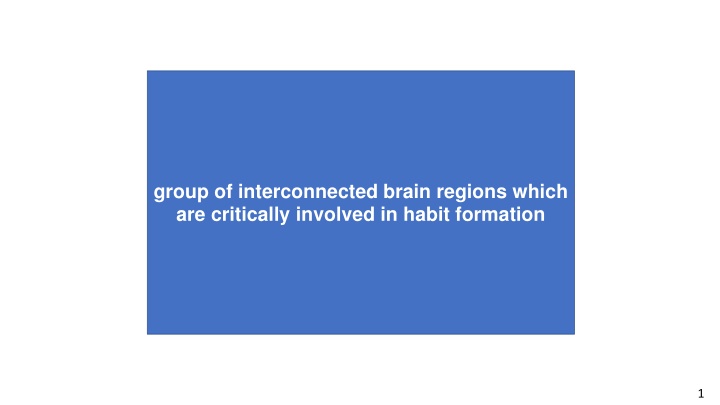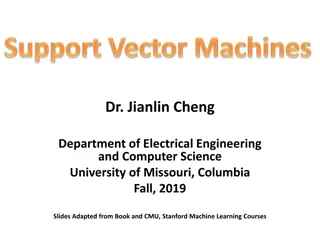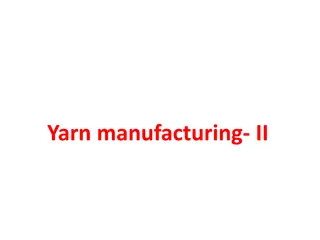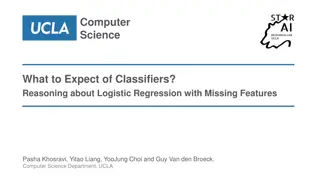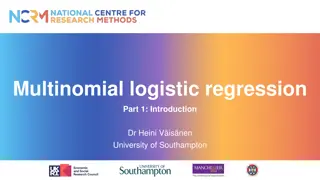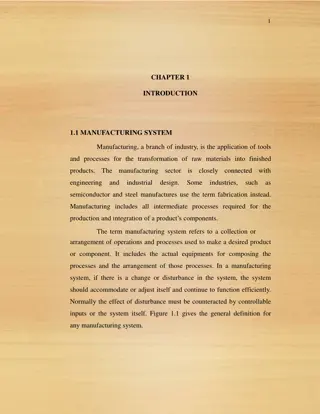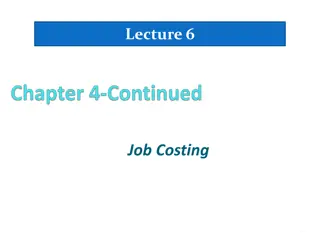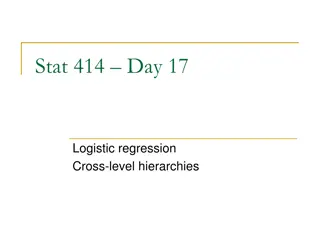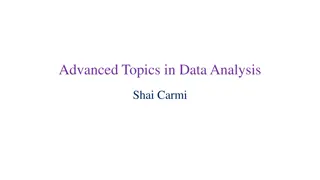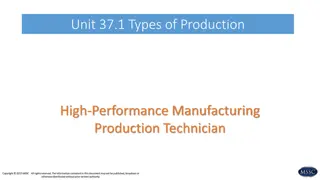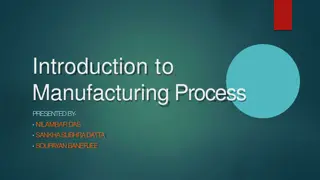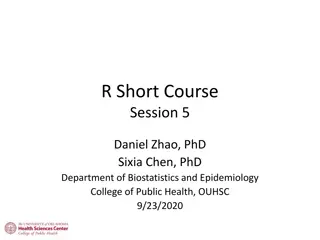Heuristical Approach of Logistic Problems in Modern Manufacturing and Service Sector
Emerging global-scale networks face NP-hard logistical problems influenced by modern trends like globalization, Industry 4.0, Internet of things, machine learning, and neural networks. Basic logistical challenges include routing, capacity management, location determination, production depth determination, and scheduling. Tools like linear programming and simple mathematics aid in resolving these issues efficiently. Location determination and area grid methods further contribute to solving complex logistical problems.
Uploaded on Feb 18, 2025 | 1 Views
Download Presentation

Please find below an Image/Link to download the presentation.
The content on the website is provided AS IS for your information and personal use only. It may not be sold, licensed, or shared on other websites without obtaining consent from the author.If you encounter any issues during the download, it is possible that the publisher has removed the file from their server.
You are allowed to download the files provided on this website for personal or commercial use, subject to the condition that they are used lawfully. All files are the property of their respective owners.
The content on the website is provided AS IS for your information and personal use only. It may not be sold, licensed, or shared on other websites without obtaining consent from the author.
E N D
Presentation Transcript
group of interconnected brain regions which are critically involved in habit formation 1
a protein that forms a light-sensitive ion channel within the neuronal membrane loss of taste 2
retinal neurons located between the bipolar and ganglion cells long-term (drug use) 3
a conditioning procedure that allows the subject to form associations between environmental stimuli such as a light and food (also called Pavlovian conditioning) loss of smell 4
anosmia classical conditioning 4
the area of the cortex dedicated to auditory processing occurrence of an unpleasant event an environmental stimulus that predicts the 5
auditory cortex conditioned aversive stimulus 5
tolerance to a drug only in environments where the individual has taken the drug in carries auditory signals from the inner ear to the brain the past 6
auditory nerve conditioned drug tolerance 6
a stimulus that is reinforcing only because it has been associated with a primary reinforcer Vibrating fluid in the cochlea causes the____ to move in a wave-like fashion in response to soundwaves. (Money is an example of a ____ ____.) 7
basilar membrane conditioned reinforcer 7
an environmental stimulus that predicts the occurrence of a pleasant Event neurons in the retina that receive visual input from photoreceptors and send output to retinal ganglion cells (The sound of the ice cream truck is a ____ ____ stimulus.) 8
bipolar cells conditioned reward stimulus 8
a previously neutral stimulus that predicts the occurrence of an unconditioned stimulus the ability to respond to visual information without conscious awareness (A tone repeatedly followed by food may become a ____ stimulus that predicts food.) 9
blindsight conditioned stimulus (CS) 9
the portion of the retina containing the optic disk and no photoreceptors another neuron makes synaptic contact a small extension on a dendrite where 10
blind spot dendritic spine 10
hearing loss resulting from disruption of the auditory signal along its route through the brain receptors a drug that reduces dopamine transmission, often by blocking dopamine 11
central hearing loss dopamine antagonist 11
A receptive field in which light hitting a particular retinal location excites a neuron, and light hitting the surrounding area inhibits it is called a ____ receptive field. the dopamine-releasing neuron a protein within the membrane of a dopamine-releasing neuron that pulls dopamine from the synaptic cleft back into 12
centersurround receptive field dopamine transporter 12
pain-sensing receptors that respond to chemical toxins the body the opioid peptides produced naturally by 13
chemical nociceptors endogenous opioids 13
the reduction in the rate of a previously learned behavior caused by reward omission a spiral-shaped structure in the inner ear containing fluid-filled canals (A rat learned to press a lever in order to receive a food reward. When the reward was no longer delivered, the lever- prbehavior underwent ____.) 14
cochlea extinction (of behavior) 14
drug tolerance caused by reduced sensitivity of drug s target sites a region of the medulla that receives input from the auditory nerve; not to be confused with the cochlea of the ear brain decreased, Bob underwent ____ tolerance for heroin.) (As the number of opioid receptors in his 15
cochlear nucleus functional tolerance 15
a neuron that responds to lines of specific orientations regardless of where the line appears in the visual field an addiction-like compulsion to gamble (c___ cell) 16
complex cell gambling disorder 16
hearing loss resulting from the inability of sound to reach the ear drum or to affect the ossicles of the middle ear doorknob-shaped enlargement at the end of a dendritic spine 17
conductive hearing loss head of a dendritic spine 17
the type of photoreceptor found mostly in the fovea and necessary for color vision (Chocolate cake has h---- properties.) pleasurable 18
cones hedonic 18
the combining of information coming from many neurons to a smaller number of neuronal recipients (c___) the ability to suppress one s attention and/or behavioral response to particular environmental stimuli 19
convergence inhibitory control 19
the learning of a relationship between a the protective outer layer of the eye behavior (e.g., pressing a lever) and a particular outcome (receiving food). 20
cornea instrumental learning 20
the neural pathway originating in layer 6 of the primary visual cortex and terminating in the LGN of the thalamus receive stimulation of the ____ ____ ____, a bundle of axons connecting the brainstem to the forebrain rats will lever-press vigorously in order to (the____ pathway plays an important role in visual attention) 21
corticogeniculate pathway medial forebrain bundle (MFB) 21
the collection of cell bodies of somatosensory neurons just outside the spinal cord accumbens a dopamine pathway that originates in the VTA and terminates in the nucleus 22
dorsal root ganglia mesolimbic dopamine pathway 22
a group of cortical brain areas that specialize in detecting the location of objects, that is, where things are drug tolerance that results from enhanced effectiveness in eliminating the drug 23
dorsal stream metabolic tolerance 23
a piece of tissue in the middle ear that vibrates in response to sound waves, also called the tympanic membrane the region of the brainstem that contains dopamine neurons 24
eardrum midbrain 24
the thin strand-like portion of the dendritic the central portion of the retina spine that leaves the dendrite 25
fovea neck of a dendritic spine 25
